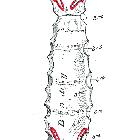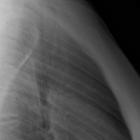Manubrium



The manubrium is the superior part of the sternum lying at the level of T3-T4 vertebrae. It forms the superior wall of the anterior mediastinum and its superior border also contributes to the superior thoracic aperture (thoracic inlet). The upper border of the manubrium also serves as the apex for the anterior triangle of the neck.
Gross anatomy
The appearance of the manubrium has been described as trapezoidal, a necktie or even a handle. It is a four-sided, flat bone and is broad superiorly. Its width tapers down inferiorly. The concave superior border is called the jugular or suprasternal notch. The smooth anterior surface is transversely convex.
Articulations
There are two angles on the superolateral corners, the clavicular notches, bilaterally beside the jugular notch. Clavicular notches form the sternoclavicular joints. Immediately inferior to the sternoclavicular joints lie the site for the attachment of the costal cartilages for the first ribs. Along the inferorlateral borders lie demifacets for the second ribs. These demifacets are shared with the body of the sternum.
The manubrium articulates with the body of the sternum at the sternomanubrial joint through a secondary cartilaginous joint (symphysis). As the two components lie in slightly different planes, the palpable sternal angle or angle of Louis is projected. This occurs at the T4-T5 vertebral level, at the transthoracic plane of Louis.
Attachments
- interclavicular ligament: attached to the medial aspect of the jugular notch running coronally
- deep cervical fascia: attached to the anterior and posterior borders of the jugular notch
- pectoralis major: attaches to the anterior surface of the manubrium
- sternocleidomastoid: tendon attaches to the anterior surface of the manubrium
- sternohyoid: attaches to the superior part of the posterior surface of the manubrium
- sternothyroid: attaches to the superior part of the posterior surface of the manubrium
Variant anatomy
Related pathology
- Fraktur des Manubrium sterni
- Ruptur der Symphysis manubriosternalis (sternomanubrial dislocation)
Siehe auch:

 Assoziationen und Differentialdiagnosen zu Manubrium sterni:
Assoziationen und Differentialdiagnosen zu Manubrium sterni:


